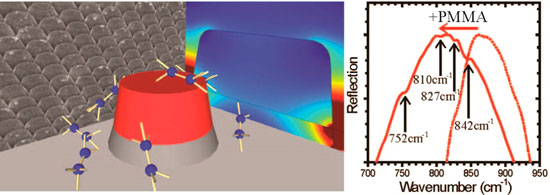| Sep 05, 2013 |
A new type of infrared plasmonic antenna for long-wavelength enhanced nanosensing
|
|
(Nanowerk News) The ability to detect distinct roto-vibration resonances is a fundamental requirement for IR sensing applications in industries including, but not limited to, food safety, pharmaceutical development and monitoring, health and biosensing, security and defense, and industrial process control.
|
|
As technologies continue to shrink in size, it is increasingly important to be able to perform such sensing with nanovolumes of materials. However, the plasmonic sensors which have found purchase at shorter wavelengths are not easily translated to longer wavelengths, due to the optical properties of their constituent plasmonic metals.
|
|
Researchers in the Micro and Nanotechnology Lab at the University of Illinois Urbana-Champaign have now demonstrated that patterned doped semiconductors can act as plasmonic nanoantennas with strongly localized optical modes in the near-field of the nanoantennas ("All-Semiconductor Plasmonic Nanoantennas for Infrared Sensing").
|
 |
| A new type of infrared plasmonic antenna for long-wavelength nanoscale enhanced sensing. The plasmonic materials utilized are epitaxially grown semiconductor engineered metals, which results in high-quality, low-loss infrared plasmonic metals with tunable optical properties. (©American Chemical Society)
|
|
This material system is particularly attractive as it allows for single crystal, low-loss, and perhaps most importantly, engineered plasmonic metals, all of which are difficult, if not impossible, to achieve with traditional plasmonic metals at short wavelengths.
|
|
Furthermore, the team demonstrates that their nanoantennas, patterned to a length scale smaller than λo/20, can detect very weak absorption resonances in nanoscale volumes of absorbing material deposited over the nanoantennas.
|
|
This work provides evidence for the potential of these novel IR antennas for long wavelength sensing applications and offers a potential route toward highly sensitive nanosensing with micrometer-scale light.
|

